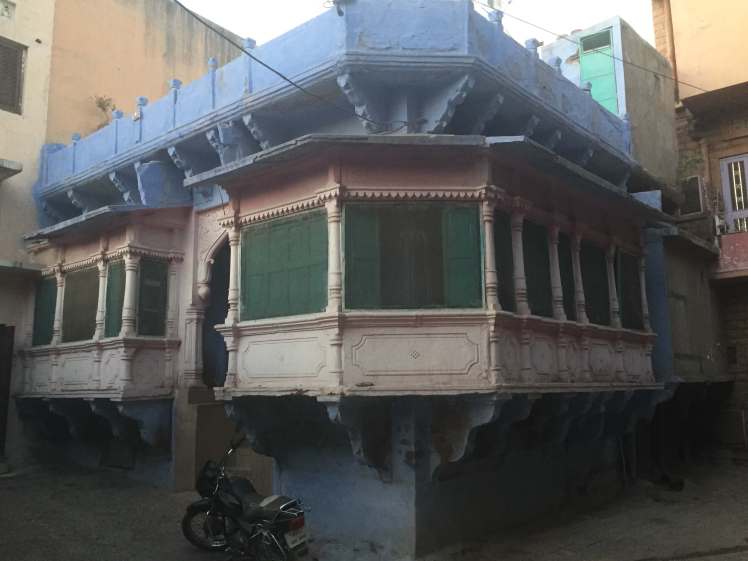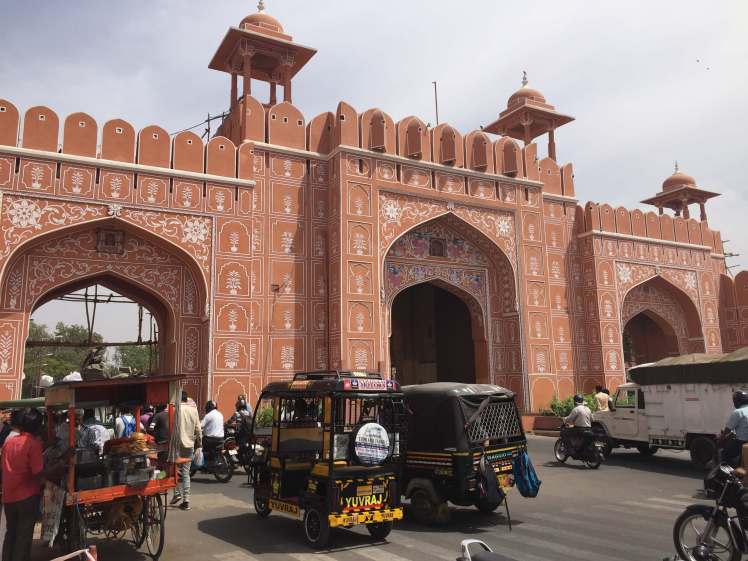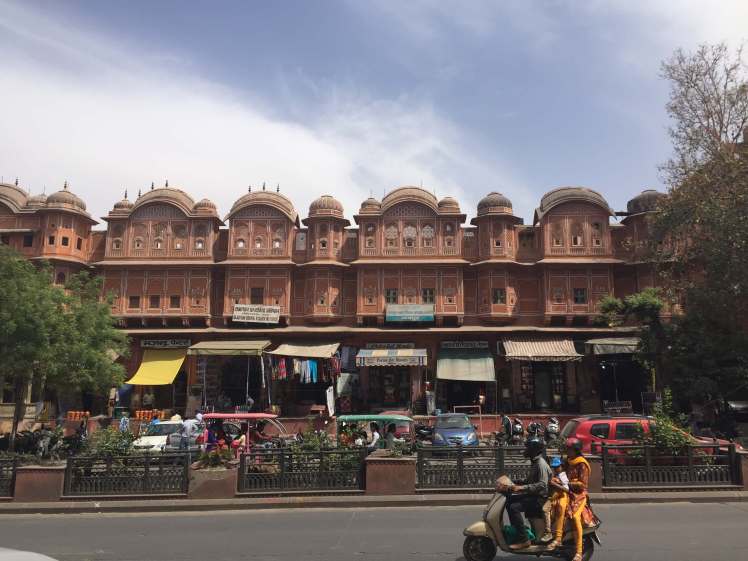From Mumbai, I flew 500 miles north to a completely different part of India. The state of Rajasthan, situated in the Thar Desert bordering Pakistan, is both physically and culturally very different from the other places I have been in India so far. Rajasthan is a hot landscape (over 100°F while I was there!) filled with hilltop fortresses once occupied by Rajput kings called maharajas and later ruled by Muslim Mughal sultans. I arrived in Jodhpur, a city in the center of the state named after its founder, the Rajput ruler Rao Jodha (pur means “city”). The city spreads out around a large hill that has steep cliffs on three sides and the massive Mehrangarh Fort perched on top. The city wall stretches along the hilltops surrounding the old quarter, while the modern city extends a little further outward before giving way to the desert beyond.
Along the city wall near the fort, I took a walk through the beautifully-maintained park called Rao Jodha Desert Rock park. Here, in what was once a withering ecosystem, numerous plant species native to the Thar desert have been planted to create an oasis of greenery and wildlife in the city. An ancient aqueduct passes through the park and carries water to two small reservoirs at the base of the fortress. The views across these reservoirs are some of the nicest in the city, in my opinion!




While Jodhpur is not a particularly large city, I found it to be full of activity and energy. There were several parades and processions through the streets involving camels, colorful chariots, people dressed in traditional outfits, and a lot of festive music. In the main marketplace, centered around a clock tower, there are merchants selling everything from flip-flops to saris in any color or pattern you could want, as well food vendors selling such delicious items as masala omelet sandwiches and saffron-flavored lassis. A few labyrinthine streets away from the market, the city’s stepwell descends several stories below the street level, ending in a deep pool of groundwater that used to be vital to the city’s survival. Now, however, it is mostly used a place for the local kids to cliff jump!


Jodhpur is a city that developed as part of the Rajput culture in which many small Hindu kingdoms were ruled by kings called maharajas. The city’s history is also closely linked to the Mughal culture, a Muslim empire that expanded into India from lands farther west and ruled for several hundred years. Coincidentally, on my last night in Mumbai, I got a taste of these two cultures at the movie theater. My friend Owaiz and I watched Padmaavat, one of the latest big-budget films to come out of Bollywood (the Hindi-language film industry). The film, filled with beautifully-framed scenes and plenty of Bollywood’s signature singing and dancing, had no English subtitles. However, with a little explanation and translation before and during the intermission, I managed to follow along pretty well.
(Warning: Spoilers! 🙂)
The story is based on a famous legend in which a ruler of a Rajput kingdom named Ratan Singh finds the beautiful princess Padmavati on a hunting trip and takes her as a second wife. Meanwhile, a power-hungry prince named Alauddin in a nearby Mughal sultanate is busy overthrowing his uncle and expanding his kingdom. When a traitor from the Rajput kingdom tells Alauddin of Padmavati’s beauty, the Mughal ruler sets out to obtain her for himself and lays siege to the Rajput fortress. After several months, Alauddin and Ratan Singh engage in some awkward diplomacy that results in Ratan Singh being taken hostage and brought back to the Mughal capital. Fortunately, Padmavati arrives and sneakily steals her husband back. Alauddin, outraged, returns in force to the Rajput fortress and overtakes it in a climactic battle, killing Ratan Singh in the process. But, the real climax comes when all of the newly-widowed royal Rajput women, led by Padmavati, process into a pyre and burn themselves alive, a Rajput tradition and a convenient method of denying their enemies the prize of slaves.
While the events of Padmaavat are said to have taken place at the nearby Chittor Fort, the Mehrangarh Fort in Jodhpur is similar in both appearance and culture. After climbing up to Mehrangarh Fort, I passed through a series of entry gates built at different times in the fort’s history. Upon entering the final gate, I was greeted by rows of red handprints on the walls – these were left by widows as they exited the fortress on their way to join their husbands on the funeral pyre. Beyond the gates, the fortress is filled with rooms furnished in traditional style and exhibiting various aspects of Rajput culture, from their weapons and chariots to their clothes and baby cribs. An audioguide, narrated in part by the current maharaja of Jodhpur himself (mainly a symbolic leader nowadays) gave interesting insight into life in the fort, involving coronations, elaborate receptions called Durbars, and a lot of eavesdropping and gossiping!




From Jodhpur, I rode the rails to the capital and largest city of Rajasthan, Jaipur. With the grid-patterned walled city in the center, newer European-influenced boulevards and architecture just outside the wall, and modern sprawl and shopping malls furthest out, Jaipur has quite a different feel than Jodhpur. Nahargarh Fort overlooks the city from a nearby hilltop, though the current maharaja of Jaipur lives in a palace in the old quarter below. The buildings of the old quarter are painted in various shades of pink, a symbolic color of welcome, giving Jaipur the nickname the “Pink City”. A few kilometers to the north of Jaipur is the Amber Fort, the original seat of the local rulers.
My visit to Jaipur was hindered by sickness and strikes. A caste-related strike was scheduled to occur on my first two days in Jaipur, and I was unfortunate enough to discover this at 2AM on Easter morning. I had just attended the Easter Vigil Mass and walked out to the street to get an Uber to take me the three kilometers back to the hostel. After a declined first attempt, the second driver accepted the ride and arrived a few minutes later. I got in, confirmed the destination with the driver, and was then told to get out of the car! Confusion and annoyingly-rude behavior on the driver’s part followed, during which I found out that he was on strike but for some reason still “accepting” rides. Anyway, I ended up on the street again and eventually managed to share a ride with some other people in the same situation, and I made it back to the hostel safely. The day after Easter, I was sick and couldn’t get out of bed, which is just as well. By that time, the strike had escalated to violent riots in the streets and the official advice was “stay inside”.
When it was all said and done, I only had a few hours to explore Jaipur, so I explored some places in the old quarter but didn’t get a chance to visit any of the forts. The Jantar Mantar, adjacent to the maharaja’s palace, was a worthwhile visit – this is the royal observatory that is unlike any observatory I have ever seen. In a large walled courtyard, the royal astronomers and astrologers have constructed a collection of various types of sundials, astrolabes, and other instruments to measure the positions of celestial bodies and zodiacs. It is an impressively broad collection, and the measurements are apparently quite accurate.






Feeling like I could spend several more days in Rajasthan, but with the clock ticking before my flight out of India, it was time to move on to my next-to-last stop. But, though the rioting was over, its effects were still being felt. I arrived at the Jaipur train station for my afternoon journey to Agra, only to find that the train was delayed by eight hours! This, it turns out, was to allow for repairs after some protesters had cut the train tracks. So, my afternoon train ride turned into a sleepless overnight ride, but I eventually made it to Agra. It seems a little like Rajasthan was conspiring against me on this trip, but I still found it to be an interesting place – there is enough that I didn’t get a chance to see (and eat – I didn’t have much appetite after being sick) to warrant a return trip someday!

I regret not riding the train in India. Although wisely, I was very careful about what I consumed.
LikeLiked by 1 person